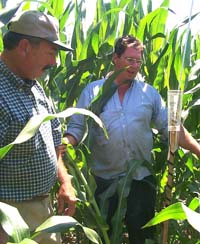Project Focuses on Times And Rates To Irrigate Corn, Soybean Crops
Project Focuses on Times And Rates To Irrigate Corn, Soybean Crops

A study being conducted in fields in Daviess and Henderson counties is trying to help grain farmers determine when to start, how much to apply, and when to stop using their center pivot irrigation.
"Basically, we started this project as a reaction to last year's drought," said Wayne Mattingly, Daviess County Extension Agent for Agriculture and Natural Resources. "What we saw were a lot of farmers using center pivots, but they were very haphazard about how they used it."
When farmers were asked why they irrigated and how much they applied, few had any real answers.
Mattingly and Mike Smith, Henderson County Extension Agents for Agriculture and Natural Resources, are conducting the research on nine farms. University of Kentucky specialists and irrigation specialists with the University of Missouri and University of Arkansas are also assisting.
The project is partially funded through an Integrated Pest Management grant from the state.
In the project, each field has been equipped with a soil moisture recorder that takes hourly readings. In addition to soil moisture monitoring, rainfall data, irrigation rates and daily temperatures are used in a computer software program called the "Arkansas Scheduler."
The program, developed at the University of Arkansas, takes into account the crop moisture needs relative to the crop's stage of development, soil type and evaporation rate.
By monitoring crop development, rainfall events and temperature, scheduling systems like the Arkansas Scheduler, can increase the efficiency of how often irrigation should be applied and the amount needed for each irrigation.
The project is also using the data collected and charting it using a different system developed by Missouri that uses rainfall and growth stage to determine the needs of the crop based on a graphing system.
Smith said they want to use several programs in the study.
"We want to find what's easier for the farmer," he said.
The farmer not only receives a weekly Arkansas Scheduler report and graphs but also an IPM scouting report.
"There's a lot of disciplines built into this project," Mattingly said.
Smith said in addition to when, how much, and for how long a farmer should irrigate, the project should also show the different irrigation needs between soybeans and corn.
Henderson County farmer Glenn Miller, a participating farmer, said he has already learned he was not giving his corn crop enough water.
During a meeting in January to kick-off the project, Miller said he learned that it takes about 12 inches of rain a season to make a corn crop.
"In the past, we hadn't been putting on enough and so this schedule is helping us achieve that," he said. "It's a nice set up and I'm glad they are taking the time to do it."
The Miller farm as been using center pivot irrigation since the 1980s, but he said they still have a lot to learn.
"I'd like to see this project continue for at least three years so we'd have some comparative data," he said.
Mattingly said they don't expect farmers to simply sit behind a computer and let it make all the decisions. But, if they take the principles and use them, that will be a benefit.